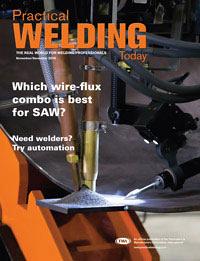Independent welding consumables professional
- FMA
- The Fabricator
- FABTECH
- Canadian Metalworking
Categories
- Additive Manufacturing
- Aluminum Welding
- Arc Welding
- Assembly and Joining
- Automation and Robotics
- Bending and Forming
- Consumables
- Cutting and Weld Prep
- Electric Vehicles
- En Español
- Finishing
- Hydroforming
- Laser Cutting
- Laser Welding
- Machining
- Manufacturing Software
- Materials Handling
- Metals/Materials
- Oxyfuel Cutting
- Plasma Cutting
- Power Tools
- Punching and Other Holemaking
- Roll Forming
- Safety
- Sawing
- Shearing
- Shop Management
- Testing and Measuring
- Tube and Pipe Fabrication
- Tube and Pipe Production
- Waterjet Cutting
Industry Directory
Webcasts
Podcasts
FAB 40
Advertise
Subscribe
Account Login
Search
Consumables Corner: Cost or classification
Selecting filler metals for cold weather toughness
- By Nino Mascalco, Rob Koltz, and Steve Sigler
- November 30, 2016
- Article
- Consumables
Q: Our purchasing team consistently tries to find the lowest price on welding consumables. In an attempt to satisfy their desire, I’m wondering, does it really matter if we use a standard AWS A5.18 ER70S-6 filler metal with 90 percent argon/10 percent carbon dioxide shielding gas? We need 20 ft.-lbs. at -50 degrees F for Charpy V-notch impact tests. Even though A5.18 requires only 20 ft.-lbs. at -20 degrees, the typical results I see from most filler metal manufacturers is well above that and actually exceeds our requirements. Should we be concerned about using this filler metal, or will we need to pay for an alloyed filler metal from A5.28 classification?
A: This is a concern that many manufacturers have. The hard-and-fast answer is yes, you need to be concerned, and you will more than likely require an alloyed filler metal. Let's take a look at why this is the case.
You are correct when you state that most of the typical testing data for an A5.18 filler metal with argon percentages above 75 percent meet or exceed your requirements. The key word here is "typical," which does not translate to guarantee. It is possible that some lot numbers or batch production runs will produce only 5 ft.-lbs. at -50 degrees, but still meet or exceed the 20 ft.-lbs. at -20 degree requirement. Keep in mind that manufacturers are only testing to meet the A5.18 requirements, so they would be unaware that it's failing to meet your requirements.
There are a number of reasons, either individually or combined, that will cause the Charpy V-notch toughness results to vary from lot number to lot number. The steel purchased by filler metal manufacturers is referred to as "green rod," which comes from one of several steel producers. Each coil of green rod will have to conform to the AWS classification they are utilizing it for and in many cases will have stricter or tighter tolerances on the chemistry to meet the filler metal manufacturer's requirements. By placing tighter tolerances on the chemistry, they are ensuring more consistent and repeatable welding arc characteristics and mechanical testing results.
The testing performed to classify a filler metal in many cases does not match the application or situations that are generally found in production. The AWS testing requirements are only interested purely in the performance of the filler metal under tightly controlled variables. This is done to form a baseline of the filler metal's performance. It would be impractical, if not impossible, to test the filler metal to meet every customer's needs. However, manufacturers will usually have supporting test data for industry-specific applications and base materials.
Other variables that may or will affect the final weld strength performance are shielding gas type, welding parameters (especially heat input for Charpy testing), weld metal base material dilution, postweld heat treating, welding technique, cleanliness of the weld joint prior to welding, weld joint design, and the stress on the weld.
Some of the filler metals from the A5.28 classification contain nickel, which greatly improves cold weather toughness. Keep in mind, for pipe welding applications, the nickel content of the filler metal may be limited to less than 1 percent to meet National Association of Corrosion Engineers (NACE) requirements for pipes used in sour gas applications.
The reality is, if the product design and/or base materials require 20 ft.-lbs. at -50 degrees, you may need to select a filler metal from the A5.28 classification or whichever one meets the design and service requirements. If someone chooses a filler metal from an AWS classification that does not meet the minimum requirements of the product design, there is a potential for catastrophic failure when the product is put into service. This could mean loss of life or very costly legal issues in which neither is ever worth the risk just to save money upfront.
About the Authors


Rob Koltz
Application Engineer
411 S. Ebenezer Rd.
Florence, 29501
636-485-2253
Steve Sigler
Application Engineer
411 S. Ebenezer Rd.
Florence, South Carolina 29501
636-485-2253
About the Publication
Related Companies
subscribe now

The Welder, formerly known as Practical Welding Today, is a showcase of the real people who make the products we use and work with every day. This magazine has served the welding community in North America well for more than 20 years.
start your free subscription- Stay connected from anywhere

Easily access valuable industry resources now with full access to the digital edition of The Fabricator.

Easily access valuable industry resources now with full access to the digital edition of The Welder.

Easily access valuable industry resources now with full access to the digital edition of The Tube and Pipe Journal.
- Podcasting
- Podcast:
- The Fabricator Podcast
- Published:
- 04/16/2024
- Running Time:
- 63:29
In this episode of The Fabricator Podcast, Caleb Chamberlain, co-founder and CEO of OSH Cut, discusses his company’s...
- Trending Articles
Sheffield Forgemasters makes global leap in welding technology

ESAB unveils Texas facility renovation

Engine-driven welding machines include integrated air compressors

How welders can stay safe during grinding

The impact of sine and square waves in aluminum AC welding, Part I

- Industry Events
16th Annual Safety Conference
- April 30 - May 1, 2024
- Elgin,
Pipe and Tube Conference
- May 21 - 22, 2024
- Omaha, NE
World-Class Roll Forming Workshop
- June 5 - 6, 2024
- Louisville, KY
Advanced Laser Application Workshop
- June 25 - 27, 2024
- Novi, MI



























